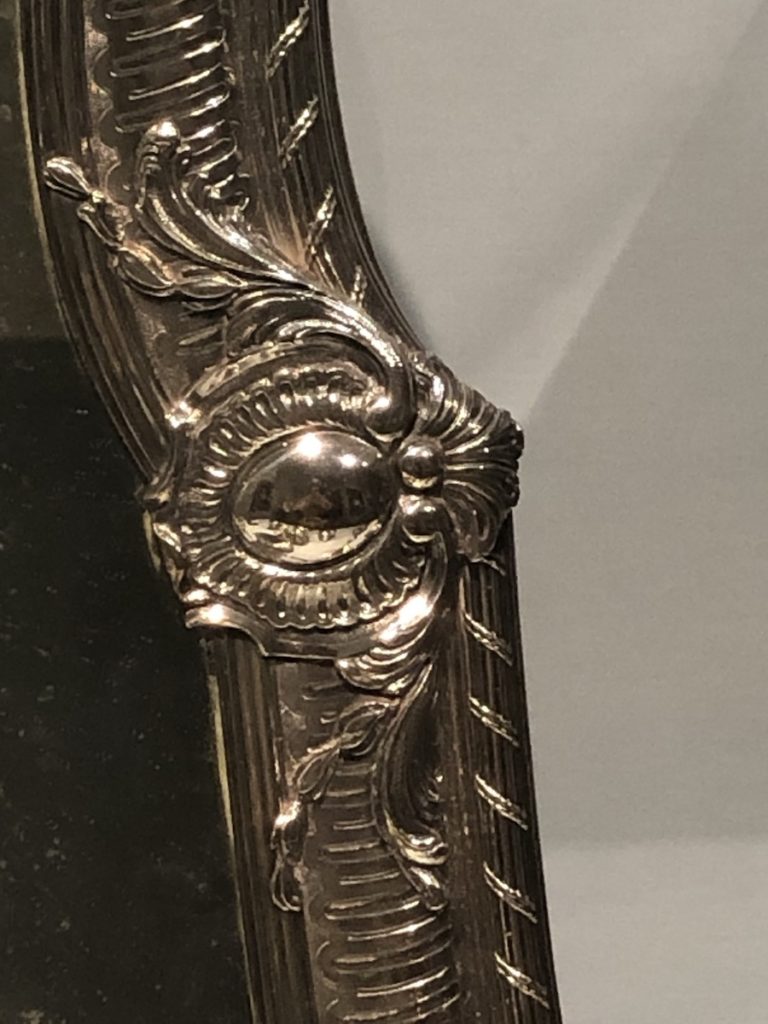Dani Ezor
In 1739, the seventeen-year-old Henriette Julie Gabrielle de Lorraine, daughter of Louis de Lorraine, prince de Lambesc, was sent to Portugal to marry the 55-year-old Jaime de Melo, duc de Cadaval. While the two families were tied by a previous marriage, this union was of paramount importance. The Cadavals, a branch of the Braganza royal family, needed the young duchesse de Cadaval to bear children and continue the family line. The duchesse brought with her to Portugal a silver toilette set as part of her trousseau, given to her as a wedding gift by the patriarch of her family, Charles, prince de Lambesc and comte d’Armagnac, who commissioned the set from Etienne Pollet, a relatively little-known Parisian silversmith, for 8,600 livres (Fig. 1). The remarkable silver toilette set—one of few eighteenth-century French-made silver toilette sets to exist today—remained part of the Cadaval family legacy through the twentieth century.[1]
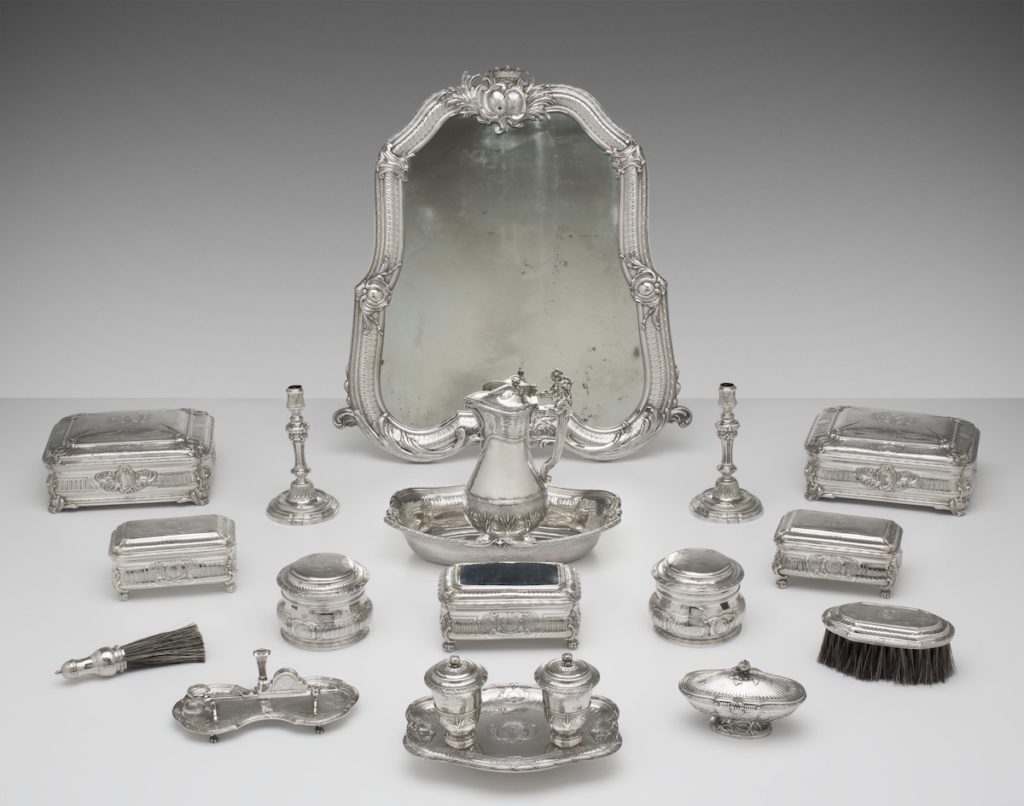
The centerpiece of this toilette set is its large mirror, complemented by an ewer and basin for washing the hands with perfumed waters, two candlesticks, a snuffer, and a tray. The set also includes two large boxes intended for gloves, hair ornaments, and other decorative pieces, as well as two small boxes and a similarly sized pin box fitted with a pin cushion on top. These smaller boxes were likely for jewelry and hair and dressing pins. Also included is an oval root box on a raised foot for storing roots intended for cleaning the teeth. Archival documents indicate that this root box once had a matching paste pot, which would have stored salves for the hands and skin. There are two more large circular powder boxes, which were once accompanied by two boxes for mouches or beauty patches, also now lost. The last two containers are a pair of covered tumblers with a matching tray, possibly used to store cosmetics such as face paint and rouge or as drinking vessels. The ensemble also features a brush and a whisk for cleaning hair powder off of garments, and it included a warming pan and a spittoon, neither of which survives.[2] Collectively, this silver set is comprised of all the objects required for the duchesse de Cadaval’s daily ritual of performing her toilette, a word referring to both the object and the event, along with accoutrements for viewing the process and perfecting the finished product: an impeccable aristocratic woman.
As the heart of elite sociability in enlightenment France, the toilette performance came to embody the eighteenth century and was a crucial site of identity construction, as acknowledged by both modern-day historians and by observers in the 1700s.[3] As an hours-long morning ritual, the toilette involved putting on makeup, getting one’s hair done, drinking newly fashionable hot beverages such as coffee, tea, and chocolate, and perhaps eating a light meal, such as a restorative broth. Although done in the home, the toilette was a public event for the wealthy, providing an opportunity to debate ideas, exchange gossip, build relationships, and conduct business. For example, Madame de Pompadour’s toilette was particularly well-known for being the locus of her power. As discussed by Melissa Hyde, Pompadour deliberately constructed her public image in paint and powder at the toilette—indeed, one of her most famous portraits depicts her there.[4] Although the toilette was not a practice reserved for women—men held extensive toilettes and owned toilette sets as well—the practice was considered overtly and often pejoratively feminine in this era. In the Encyclopédie’s (1751-1766) entry on the toilette, the author, Louis de Jaucourt, states that men performing this ritual “have in our day become women.”[5]
In addition to being intimately associated with femininity, the toilette was also intertwined with whiteness. White skin was the beauty standard in eighteenth-century Europe. Antoine Le Camus, the author of the most prominent beauty manual in eighteenth-century France, Abdeker, or the Art of Preserving Beauty (1754), identifies whiteness as the ideal skin color: “We reckon a white skin, whose surface is spread over with the color of roses, to be the most perfect and the most agreeable.”[6] This characterization of white skin as the epitome of feminine beauty came at a time when the European understanding of race was varied and unsettled. In 1684, François Bernier published “The New Division of the Earth” and codified racial differences in terms of physical appearance, including skin color.[7] Just one year later, in 1685, Louis XIV officially gave the decree for the Code Noir, which legalized the French slave trade and codified racial distinction. Although the French colonial state would change over the next hundred years, with European colonialism came a change in the perception of skin color as the defining trait signifying racial identity.[8] Over the course of the long eighteenth century, other philosophers such as Montesquieu, the Comte du Buffon, Carolus Linnæus, and Immanuel Kant discussed at length the origins of racial difference and the location of race within the human body.[9] While these philosophers disagreed on many points, what they did agree on is that white European was the ideal race and the highest rung on the racial ladder. At the end of the eighteenth century and into the nineteenth, scientific racism, which determined race to be a “biological fact,” emerged from the fray as the singular agreed-upon definition.[10]
In this article, I argue that the toilette set’s tangible, obdurate, and shiny material qualities created, embodied, and performed the intangible and insubstantial categories of nobility, femininity, and racial whiteness. I begin by considering silver as a colonial material, as specie, and above all as fuel for the fire of European colonialism, since silver, mined in the Americas, facilitated European empire and trade not only in the Americas but also on the global stage. Then, I consider the physical properties and aesthetics of silver, which I argue depend on the concept of transformation. Finally, I address the cosmetics that the silver vessels contained as agents of identity creation and metamorphosis at the toilette and their relationship to the construction of white femininity. Throughout, I analyze how the Cadaval toilette, as a surviving case study representative of the many silver toilettes that no longer exist, constructed white femininity as a microcosm of French colonial aspirations.
Silver as a material is a colonial product. In the eighteenth century, approximately 90% of the world’s silver was mined in the Americas: in Peru, Bolivia, and Mexico.[11] Not only was silver the standard metal for coinage for much of Europe at this time, but China had also recently moved to a silver standard, becoming a massive end market for silver in the early modern era.[12] Silver fueled the global economy and perpetuated the cycle of colonization in the Americas, as silver funded more colonial projects, including more silver mines.
The silver trade (both legal and illegal) over which Spain maintained a monopoly throughout the seventeenth and eighteenth centuries was deeply tied to the slave trade.[13] In Spanish America, the legal import of enslaved Africans was paid for by Spanish silver, and the asiento, or legal contract for the trafficking of enslaved people to colonial Spain, was highly sought after. One of the first acts that Louis XIV undertook after his grandson ascended the throne of Spain as Philip V (r. 1700-1746) was to secure the asiento de negros for the French, and he did this successfully at the beginning of the War of Spanish Succession. Ultimately, however, he ceded the asiento to the British in the Treaty of Utrecht, an agreement that brought the war to a close while keeping Philip V on the throne of Spain.[14] The illegal trade in this precious metal, accounting for between 33% and 50% of the total amount of silver mined in Spain’s colonies during the eighteenth century, also primarily exchanged silver for enslaved Africans.[15] Furthermore, Indigenous people were enslaved through the mita, a system of mandatory labor-based tribute from the Inca Empire that the Spanish adopted and intensified, and were forced to do the dangerous and physically taxing labor of mining silver in South America.[16]
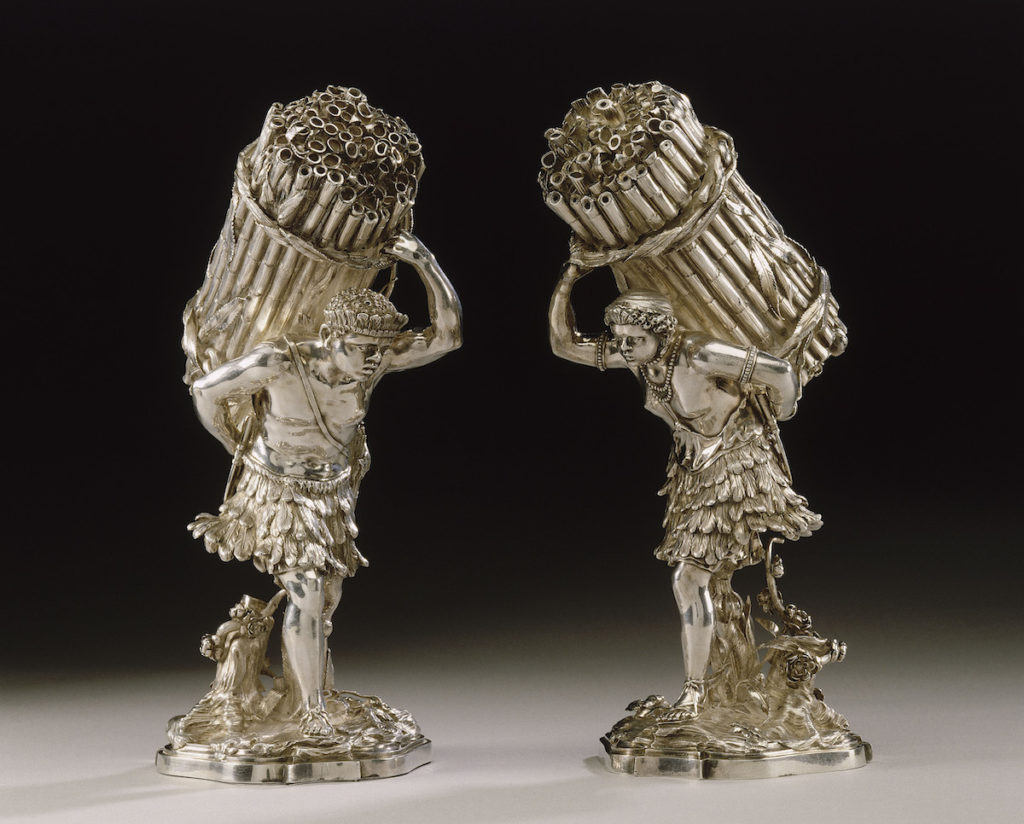
In the European context, silver could not be divorced from its colonial origins or its connection to the slave trade and the forced labor of Indigenous people in silver mines. Out of all the mines that Diderot discussed in his entry on silver in the Encyclopédie, he writes the most on the mines of the Americas, specifically Potosí, and he refers to them as the “most rich and most abundant” of all silver mines.[17] One of the few depictions of the enslaved laboring body in eighteenth-century French art prior to the Revolution is a pair of silver sugar casters (Fig. 2). These silver sugar casters take the form of an enslaved man and woman carrying sugar cane on their backs, struggling under the weight of the bundled cane. The pair explicitly depicts enslaved Black labor, as such forced labor produced all of France’s sugar cane, but the couple wears stereotypical Indigenous dress, with feathered clothing and a feathered headdress, implying Indigeneity from the Americas. The woman also wears a beaded necklace or collar, which functions as a sanitized or aestheticized symbol of slavery, especially in French images of enslaved Black women.[18]
In depicting the couple as neither overtly Black nor overtly Indigenous, these sugar casters sugarcoat the sugar industry, which was fueled both by forced Black labor—especially considering that much of the Indigenous population throughout the Caribbean had been exterminated by European conquest and disease—and by the forced Indigenous labor that produced the material used to pay for the slave trade and slavery as an institution.[19] In their ambiguity, these two figures represent the Americas as a concept and colonialism and its spoils in the Americas at large. As such, these sugar casters demonstrate what the Americas were for in the minds of the French: the harvesting and extraction of raw materials, whether sugar or silver, and the refined and sweetened consumption of these materials by France. Like the silver toilette set, these casters are the result of the complex interconnectedness of silver, sugar, and enslaved labor.[20]
The trade in silver, closely connected to the Atlantic slave trade and European colonialism, was driven by silver as specie. This monetary value cannot be divorced from its materiality, as silver was literally worth its own weight, whether in the form of coinage or as furniture, serving plates, or toilette sets. Those who owned silver in France during the long eighteenth century were certainly well aware of this fact, as on three occasions (1689, 1709, and 1759) the monarch requested the donation of their silver to the royal mint. On the first occasion, Louis XIV was the first to donate his own prized silver furniture to be melted down to fund the Nine Years War (1688-1697), a mere three years after the set was completed. In 1709, the monarch again requested silver donations to fund the War of Spanish Succession (1701-1714), which Louis de Rouvroy, duc de Saint-Simon, recorded in detail in his Mémoires. This decree was not welcomed, but the aristocracy felt obliged: “This noise caused a great annoyance at court: no one dares to not offer their silver, but everyone did it with great regret.”[21] Saint-Simon even admits he only donated his silver plate due to peer pressure:
When I saw that I was almost the only man of my rank still dining off silver, I sent plate worth about 1,000 pistoles to the mint and locked up the rest. I had some plain silver which had belonged to my father, the kind which I do not regret giving.[22]
However, Saint-Simon’s reluctance to donate was not solely due to his dislike of eating off of earthenware nor his desire to keep his silver as a last financial resource. He also acknowledged the considerable loss of craftsmanship that was the result of sending this silver to be melted down: “But the loss and the harm to all of the workmanship; the moldings and engravings, and other ornaments which luxury had introduced to the rich and those with taste, was inestimable.”[23] The royal mint would measure silver’s exchange value through its weight and compensate in silver specie at a later date, but the form of that dining set or toilette set that was donated would be lost indefinitely.[24]
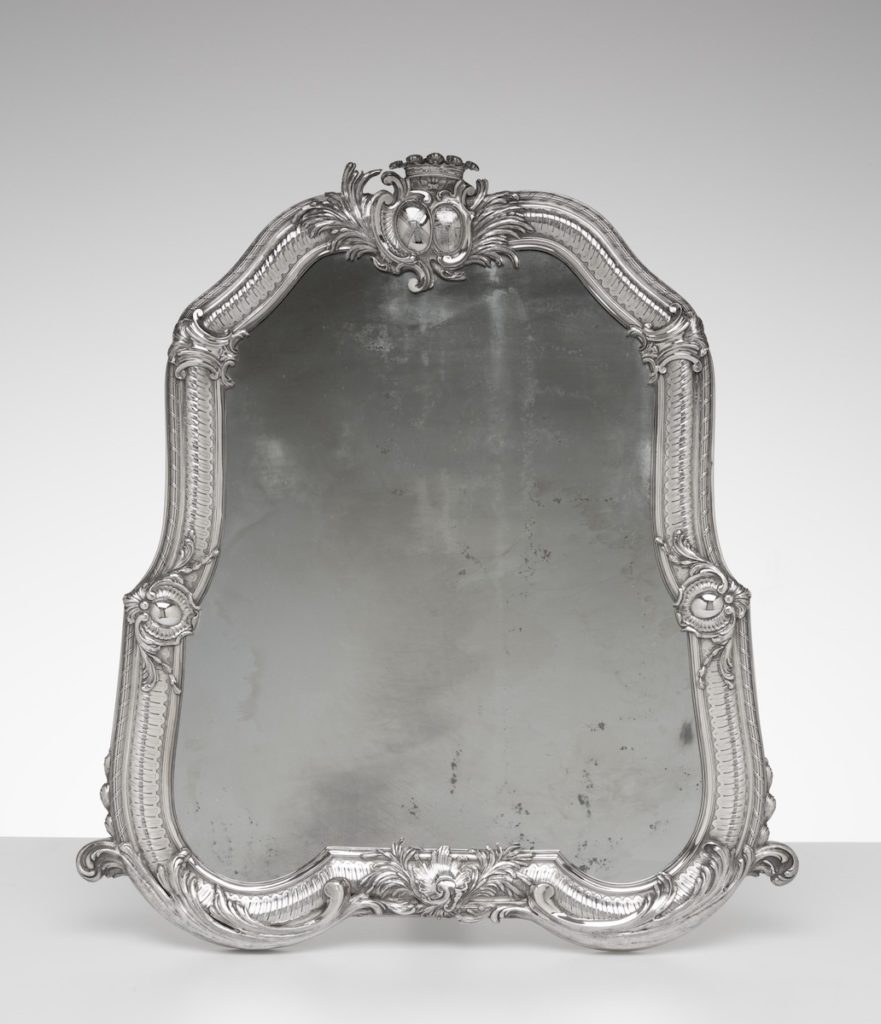
In his concern over the loss of craftsmanship, Saint-Simon highlights an element of silver’s materiality that increased its value beyond the monetary: its material qualities, its shine and color, and its transformative ability. Although Saint-Simon focuses on form and ornament, which hint at the material property of silver that allows for it to be manipulated in extraordinary ways, I would like to emphasize those properties of silver that are almost so simple as to be overlooked: color and shine. Silver reflects all wavelengths of light, which gives it its white color.[25] This whiteness was considered one of the core properties of silver that made it desirable in the eighteenth century. The Encyclopédie defines silver as “a metal the Chemists call perfect, precious, and noble. It is white when polished; fine, pure, pliable.”[26] These terms, not just white but also noble and pure, recall Enlightenment discussions of racial whiteness, which, in addition to being associated with the color white—despite the description of European skin color not as white but as fair—were also associated with nobility, as in distinguished by a higher moral and intellectual character, and purity, or the concept that whiteness as the base race that can be tainted or become impure by racial mixing.[27] As objects of pure silver—not an alloy like bronze or a mixed material like porcelain—the toilette’s materiality reflects the European aristocratic ideals of racial whiteness and purity.
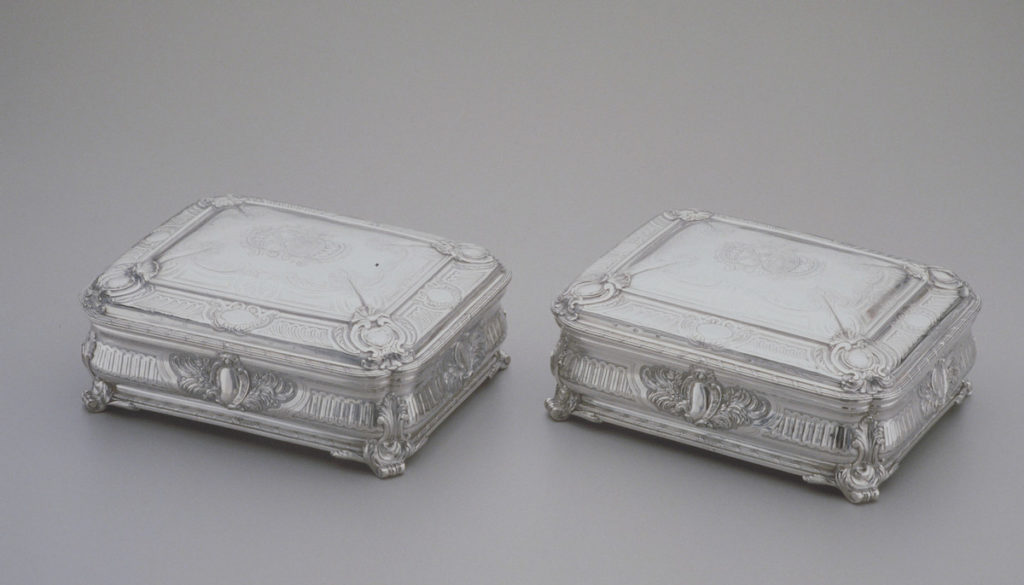
These core values were central to the construction of the duchesse de Cadaval’s identity as an aristocratic woman of Europe. First and foremost, the condition of the toilette set as a gift would have reminded the young woman of her need to project her noble birth and her role in furthering the Cadaval family line, and the toilette’s decoration reinforces this relationship to the role of the aristocratic woman. Not only was this gift intended to mark the duchesse’s new status and position, but her uncle specifically requested that the silversmith model her toilette set after those made for Louis XV’s daughters, the royal princesses.[28] While the design is not uniform across each piece, almost every object in the set is engraved with the dual coats of arms of the houses of Lorraine and Cadaval, from their prominent place on the top of the mirror and the tops of the four boxes, both small and large, to their petite and almost hidden placement on the back of the candlesnuffer or the interior of the lid of the root box (Figs. 3, 4, 5, 6a-b, 7a-b). The toilette, where she physically constructs her outward identity, functions as a constant reminder of her nobility and the expectation that she will continue the purity and prestige of the Cadaval family line, for which she is now responsible.
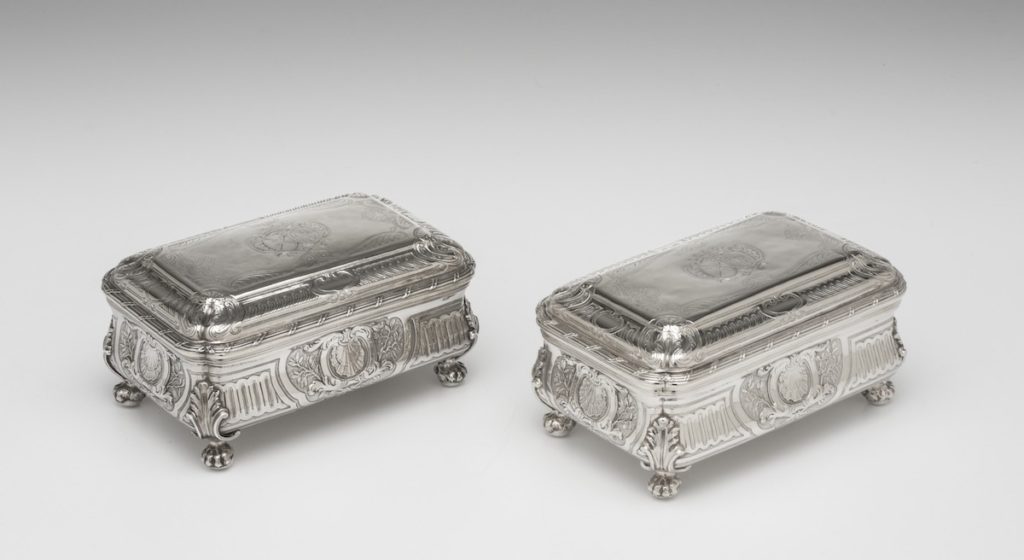
Silver’s connection to the role of the noble wife may have been reinforced by the early modern understanding of ecology as a “geocosm.” This belief likened the earth to a human body, specifically a female body, as Carolyn Merchant discusses in her essay “Nature as Female.”[29] The earth was a womb, and raw material, from dirt to ore, was the stuff of life. Human activity, such as farming, or mining and refining ore, acted as the male seed needed to enliven the earth’s womb and produce the fruit, literally or symbolically. Silver itself is the product of mother nature’s womb, and, in refining and shaping silver, man forms life out of the stuff of the earth.[30] The use of such refined and polished silver in the Cadaval toilette set accentuates the intended outcome of the union—an heir—which is further emphasized by the décor. For example, a pomegranate, a symbol of fertility, tops the lid of the root box, and the shell imagery, which can represent maternity (as pregnancy was often likened to ocean voyages in eighteenth-century France), is abundant (Figs. 4-9).[31] Altogether, the emphasis that the set places on the duchesse’s role as wife and mother would have strongly influenced her self-fashioning at the toilette, a clear reminder of her duty to produce a “perfect, precious, and noble” Cadaval heir.
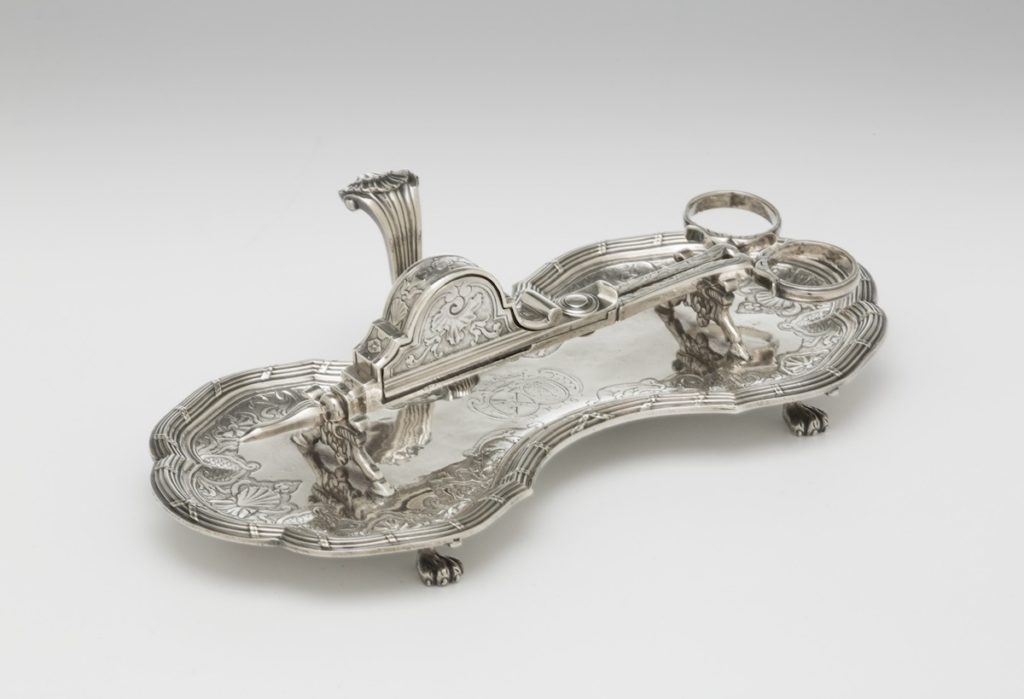
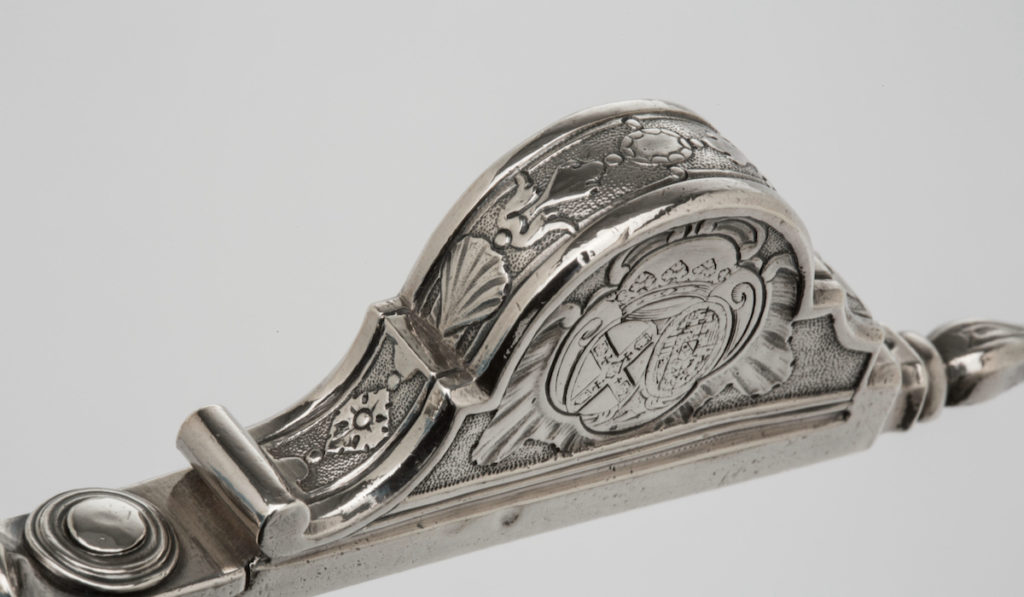
Another property of silver, its reflection or shine, complicates a one-to-one comparison of skin to material, as shine is one quality not associated with racial whiteness but rather with objecthood and conspicuous consumption. Krista Thompson argues convincingly that silver’s shine reinforces the material’s association with commodities and ultimately with the commodification of the Black body and slavery. Thompson proposes that shine or reflection was a core element of visualizing surfaces in early modern European art.[32] The exception to this interest in surface quality was white skin, which was explicitly not rendered with sheen, removing white skin from the realm of objects and the commercial world. However, shine was fundamental to the enslaved Black body, as enslaved Africans were often oiled or greased to “make them shine” before they were sold.[33] The purpose was to cover over old scars or distract from other negative qualities that may have lowered the desirability of an individual, but shine also distanced the Black body from humanity and associated the Black body with commodities and consumption. In Thompson’s words, “the reflective surface of the black body—what might be characterized as the visual production of the slave sublime—served to blind buyers, if you will, to the slave’s humanity.”[34] Silver’s shine, “white when polished,” further emphasizes the importance of surface, as the polishing of the silver, which creates its shine, also reveals its whiteness. Whiteness, too, had to be continually produced, marketed, and sold, as it had to be fashioned through cosmetics, luxury goods, and status symbols. Whether consciously or subconsciously, silver’s shine would have emphasized the material’s relationship to the construction of racial whiteness through its connection to commodity: to the commodification of Black and Indigenous labor, of European colonial conquest, and of whiteness.
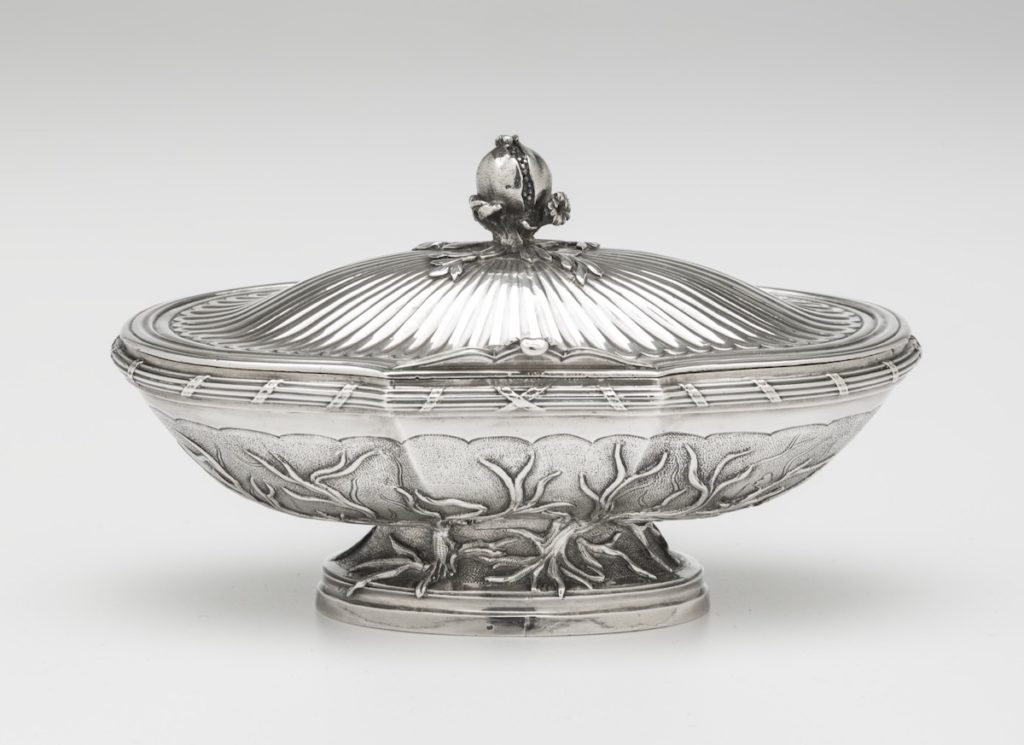
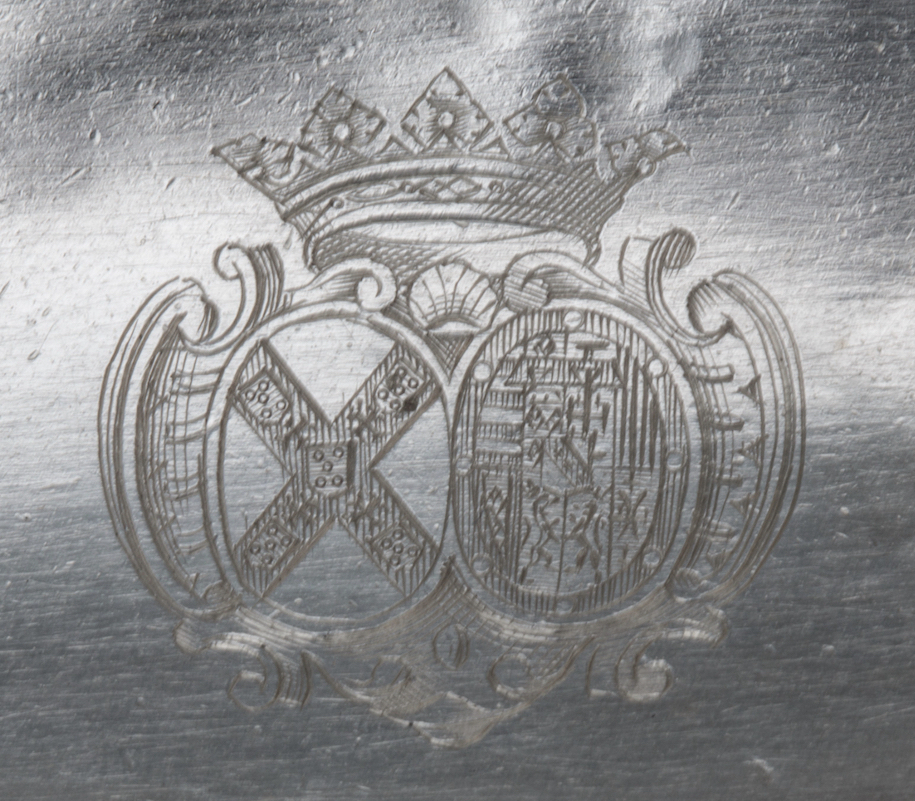
Returning to the toilette set of the duchesse de Cadaval with the connection between materiality and slavery in mind, we can consider these objects in terms of their material and their relationship to racial definitions of the self. The set is an almost overwhelming amount of silver, originally weighing approximately 58 pounds.[35] Visually stunning, each curve and polished surface gleam a bright white. In the museum setting with abundant, even lighting, its shine is spectacular, but in the eighteenth-century interior, with fewer and more uneven light sources, the silver would have become a magnificent source of light itself. When polished, this set would have reflected every hint of light cast on it, twinkling and glimmering as candles flickered.[36] In short, the silver toilette set makes the viewer overtly aware of its materiality and mutability.
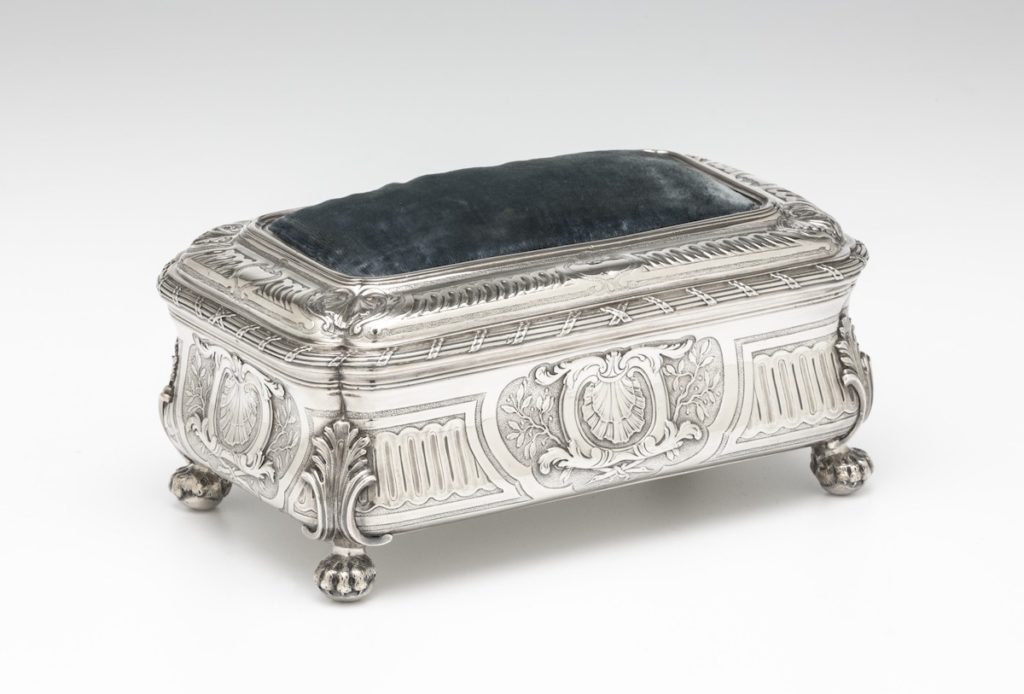
While not as glamorous or eye-catching as silver’s reflectivity, silver’s pliability and ductility—its material ability to be stretched very thin, to be worked and reworked, to be melted down and reformed, all without losing any of its celebrated properties or mass—are possibly its most remarkable qualities. Silver is the second most pliable and ductile metal (the first being gold), and these qualities are what allow for the remarkable suite of techniques employed in the crafting of silver objects, many of which are featured in the Cadaval toilette set. Despite the myriad of techniques used by silversmiths, silver objects, no matter how impressive, were often sent to the mint to be melted down. Silver can be transformed from a toilette set to a silver coin and back to another object many times over without any loss in quantity, strength, structure, stability, or base appearance.
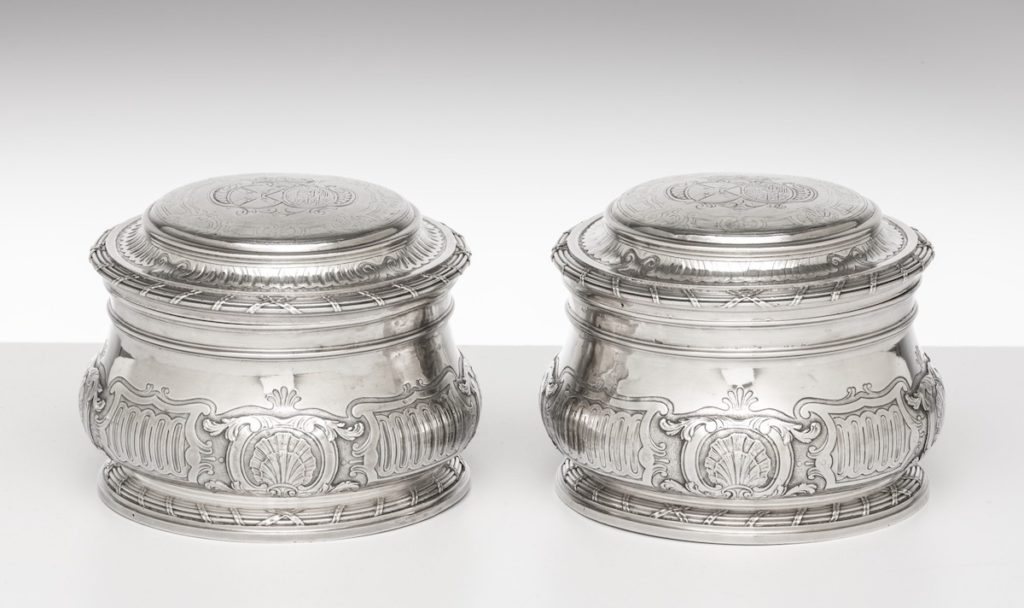
The transformative property of silver is an unfixed transformation in that the transformation can be redone and reformed without any loss. I propose that this unfixed transformation is central to eighteenth-century conceptions of identity, which Dror Wahrman argues are also unfixed.[37] These conceptions of identity meant that men could be feminine and women could be masculine, as they are shifting and unfixed identities, but it also implies that gender identity was constructed outwardly and socially performed. Furthermore, the performance or donning of gender was a form of transformation. Like gender, race was also thought to be malleable, changeable, and unfixed in the earlier part of the century, and both were “scientifically” fixed into a biological “fact” at the end of the eighteenth century and throughout the nineteenth century through pseudo-scientific racism. While there were certainly racial essentialists in the eighteenth century, the overarching trend was towards a mutable conception of race, primarily through climate theory, as proposed by the Comte de Buffon. Climate theory posed race as an effect not of biology but of environment. Thus, skin color could be changed by a shift in environment.[38] Outside of climate theory, the mutability of race was also “proven” by the scientific marvels of Africans with vitiligo or albinism.[39]
If race and gender are unstable categories, they require an outward construction. Wahrman argues that dress was where eighteenth-century identity was formed and was the locus of identity, one of the advantages of this being that dress could be transformed or shed at will, emphasizing identity’s fluid nature.[40] While Wahrman focuses on clothing, cosmetics functioned in the same manner. Not only was makeup an element of dress that could likewise be shed or changed at will, but makeup was also a transformative material focused on the external construction of white femininity in the eighteenth century. As the material of unfixed transformation, silver physically mirrored the Enlightenment ability to transform one’s gender and racial identities, especially when that silver was used at the toilette for storing and putting on cosmetics.
The centerpiece of the Cadaval toilette, and of most toilettes, is the mirror (Fig. 3). More than two feet tall and weighing over 24.5 pounds, it physically and visually outshines the other objects in the set. The glass mirror was the height of luxury consumption, a technological feat.[41] Even when they were not encased in silver mounts, mirrors of this size were extraordinarily expensive.[42] The glass mirror’s large reflective surface area would have illuminated the interior, multiplying the amount of light in the room, a highly desirable quality in eighteenth-century décor. Its reflexivity and shine would have also drawn attention to the mirror itself, and the mirror in this toilette set is one that begs for attention. The violin shape is quite distinct, following the contour of the sitter, widening at the bottom to provide more room for the sitter’s shoulders. The curve of the silver mount, decorated with asymmetrical scrolls and acanthus leaves creating a natural Rococo effect, provides a delicate frame for the duchesse to gaze at her self-crafted image in the mirror.
Another reason that the mirror was a core element of the toilette was that the act of gazing at oneself in the mirror was a symbol of luxury and nobility. In his Encyclopédie entry on the “Toilette des dames romaines,” Jaucourt writes that “A woman at her toilette hardly loses sight of her mirror; whether she is practicing her charms, or learning to adjust her looks, or studying the effects of her pose, the mirror must be her home.”[43] The mirror allows for sociability and for the sitter to learn and demonstrate the “work of leisure.”[44] It is in front of a mirror that a woman of rank learns how to sit, look, pose, put on makeup, and project herself to others—in other words, how to be a woman.
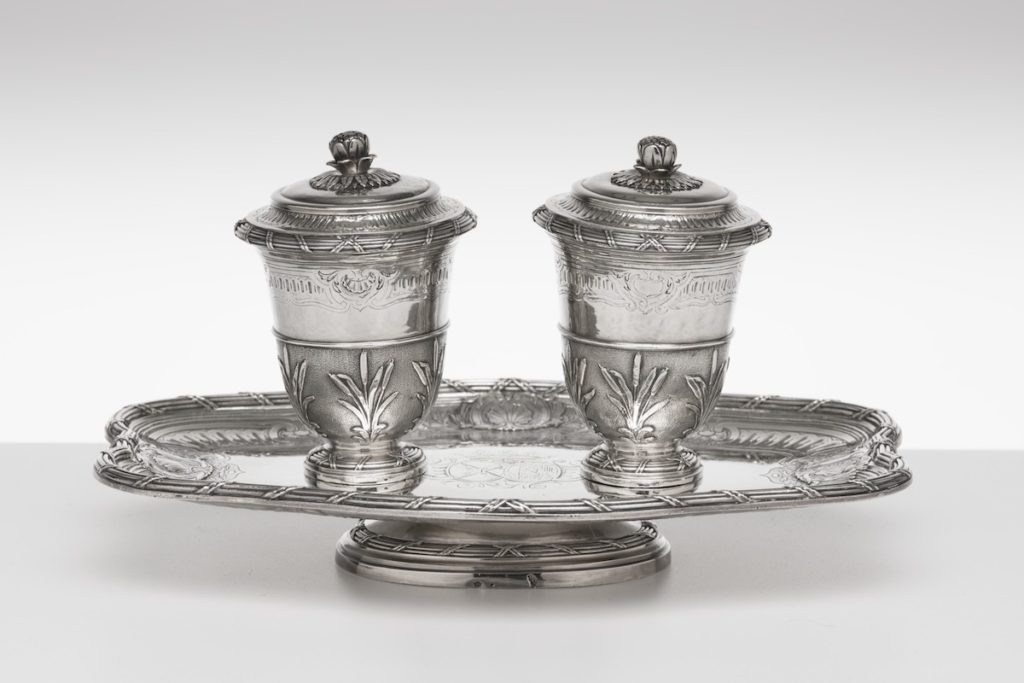
This transformed, exterior self, fashioned in the mirror, was created with cosmetics. To understand the role of cosmetics in identity construction, we must first begin with the idea that cosmetics do not construct individuality but rather collective identity.[45] As Ange Goudar wrote in L’espion chinois (1765): “Nothing is easier had in Paris than beauty… As white and red are the same everywhere, all faces are alike.”[46] The white face highlighted with rouge was the standard of beauty worn like a uniform. One can imagine the duchesse using the two cosmetic pots, one containing white and the other red, to paint on her face, her whiteness, and her femininity each morning, bringing this elite fashion with her to Portugal (Fig. 10).
While beauty may have been easy to find at court, its materials came from abroad. The highest quality rouges had colonial origins: brazilwood and sandalwood, both tropical hardwoods imported from colonial South America and the Caribbean. The most intense and expensive red, cochineal, was another colonial import from the Americas, often farmed using enslaved labor.[47] One French traveler, Jacques-Henri Bernardin de Saint-Pierre, wrote in a l769 letter:
The beautiful colors of rose and fire that our ladies wear, the cotton which they use for their dresses, the sugar, coffee, and chocolate they consume at their lunches, the rouge that enhances their whiteness: the hands of the poor Black people have made all of this for them.[48]
These materials came from the colonies and were made or harvested by enslaved people, and through the commercial networks of empire, the toilette and its cosmetics became a microcosm of this empire. In the Cadaval toilette set, the mirror physically reflects this microcosm as well. Highly polished globes project from the center on each side of the mirror’s frame, and due to their angle and convex surface, these protuberances reflect not just the sitter but the entire toilette table sitting in front of the mirror as well (Fig. 11). The mirror itself physically and symbolically reflects the toilette table as a microcosm of eighteenth-century identity creation and of the French (and Portuguese) colonial project, not only through the silver but also through the myriad colonial materials used in cosmetics and at the toilette table.
Originally indicative of a desire for morality, whiteness in cosmetics began to be understood as an evocation of race by the early eighteenth century.[49] The novel and beauty manual, Abdeker, demonstrates this association between race, skin color, and the cosmetic whitening of skin. Le Camus directly associates skin color with race: “[Skin color] is the characteristic sign of temperament.”[50] The language echoes Linnæus’s racial divisions and associations with the four humors and temperaments. Moreover, whiteness is not just the ideal, but not having white skin indicates some personal or moral failing:
I will now speak of something even more interesting, as it is the first thing that makes an impression upon the eye. It is the color of the skin, which when it is pale, yellow, brown, black, purple, is disagreeable to the eye, because it signals a certain defect in the person who has that color skin.[51]
It is no surprise, then, that Abdeker offers multiple recipes for whitening the skin, and while the story takes place in an “orientalized” Near East, the beauty lessons within the story and the recipes were intended for French use. Cosmetics created a platform for eighteenth-century Europeans to overtly construct and outwardly display racial whiteness, a whiteness literally and metaphorically reflected in silver’s materiality.
All of these factors—silver’s color, shine, reflectivity, and pliability, its colonial origins, its material value—come together in the duchesse’s experience of her silver toilette set. One can imagine the duchesse de Cadaval using the toilette objects to examine her image, practice her social graces, and construct the identity that she was expected to embody, one of elite white femininity. Crowned with the arms of her paternal and marital houses, the toilette would constantly remind her of her roles as daughter, wife, and mother and of her primary duty to produce not just any offspring but white and aristocratic offspring, as would the condition of the gift itself, being part of her trousseau. The shining silver mirror would frame her portrait every morning as her face was painted. She created the image of her exterior self in white and red while surrounded by reminders of the requirements of her rank and gender, wrought in silver, a material of colonialism.
At first glance, the Cadaval toilette might appear as another Rococo example of the luxurious consumption of aristocratic women, from its shining silver surfaces to its many cosmetic pots and jewelry boxes. This toilette, however, is not just a beautiful thing for the amusement of beautiful women but rather an object that creates beauty: specifically, an idealized, white, feminine beauty. In its function, as a toilette set for the application of cosmetics to achieve a standard of beauty founded on a racist preference for whiteness; in its purpose, as a gift on the occasion of marriage, the primary purpose of which was to produce noble white heirs; in its material of silver, a colonial resource inextricably linked with slavery; and in its form and design, this toilette set exemplifies how white femininity was fashioned at the toilette and how silver as a material for these objects reinforced the hierarchies of these identities.
Dani Ezor is a PhD candidate in Art History at Southern Methodist University in Dallas, TX specializing in eighteenth-century material culture
[1] Being part of the legacy, which meant the toilette was attached to the title of duc de Cadaval, indicates that this was one of the most highly valued objects within the Cadaval family home. This suggests to me that it was at the very least on display if not actively used, which I believe it was as many of these toilettes were.
[2] Archives Nationales, Paris, T 4915. For more information regarding the Cadaval toilette set, see: Yves Carlier, “Details of the Toilet Service of the Duchesse de Cadaval,” Bulletin of the Detroit Institute of Arts 78, 1-2 (2004): 4-17; Tracey Albainy, “Eighteenth-Century French Silver in the Elizabeth Parke Firestone Collection,” Bulletin of the Detroit Institute of Arts 73, 1-2 (1999): 8-29; P. Grigaut, “An Eighteenth-Century French Silver Toilet Set in Detroit,” Bulletin of the Detroit Institute of Arts 33, 1 (1953-54): 12-13.
[3] Melissa Hyde, Making up the Rococo: François Boucher and His Critics (Los Angeles: Getty Research Institute, 2006); Mimi Hellman, “Furniture, Sociability, and the Work of Leisure in Eighteenth-Century France,” Eighteenth-Century Studies 32, 4 (Summer 1999): 415-445; Kimberly Chrisman-Campbell, “Dressing to Impress: The Morning Toilette and the Fabrication of Femininity,” in Paris: Life & Luxury in the Eighteenth Century, ed. Charissa Bremer-David (Los Angeles: The J. Paul Getty Museum, 2011): 53-74; Ewa Lajer-Burcharth, “Pompadour’s Touch: Difference in Representation,” Representations 73, 1 (Winter 2001): 54-88; Morag Martin, Selling Beauty: Cosmetics, Commerce and French Society 1750-1830 (Baltimore: Johns Hopkins University Press, 2009). See also Tobias Smollet, Travels through France and Italy (London: R. Baldwin, 1766); Charles de Secondat, baron de Montesquieu, Lettres persanes (1721); Louis-Sébastien Mercier, Le Tableau de Paris (1781-1788).
[4] Melissa Hyde, Making up the Rococo, chapter 3.
[5] Louis de Jaucourt, “Toilette,” Encyclopédie, 35 vols. (Paris: Briasson, 1751-65), 16: 382. “…ou même des hommes qui de nos jours sont devenus femmes.” All translations are my own unless otherwise noted.
[6] “On pense qu’une peau bien blanche, sur la superficie de laquelle se trouve répandu un vernis de rose, est la couleur le plus parfait & la plus agréable.” Antoine Le Camus, Abdeker, ou l’art de conserver la beauté (Paris: Cuchet, 1754), 151.
[7] François Bernier (anonymous), “A New Division of the Earth According to the Different Types of Races of Men who Inhabit It,” Journal des Sçavants (24 April, 1684), republished in History Workshop Journal 51, trans. Janet L. Nelson (Spring 2001): 247, 248. See also Siep Stuurmann, “François Bernier and the Invention of Racial Classification,” History Workshop Journal 50 (Autumn 2000), 4.
[8] Mechthild Fend, Fleshing Out Surfaces: Skin in French Art and Medicine 1650-1850 (Manchester: Manchester University Press, 2017), chapter 5.
[9] Montesquieu, De l’esprit des lois (1748); Georges-Louis Leclerc, Comte du Buffon, L’histoire naturelle: L’histoire naturelle de l’homme (1749); Carolus Linnaeus, Systema Naturae (1758); Immanuel Kant, Observations on the Feeling of Beautiful and Sublime (1763); Immanuel Kant, Of the Different Races of Mankind (1775); Johann Friedrich Blumenbach, On The Natural Varieties of Mankind (1776).
[10] David Bindman, Ape to Apollo: Aesthetics and the Idea of Race in the 18th Century (Ithaca, NY: Cornell University Press, 2002).
[11] Ward Barrett, “World Bullion Flows, 1450-1800,” in The Rise of Merchant Empires: Long Distance Trade in the Early Modern World, 1350-1750, ed. James D. Tracy (Cambridge: Cambridge University Press, 1990), 224-225; Dennis O. Flynn and Arturo González, “Cycles of Silver: Global Economic Unity through the Mid-Eighteenth Century,” Journal of World History 13, 2 (Fall 2002): 407.
[12] Flynn and González, “Cycles of Silver,” 391-414; Chi-Ming Yang, “Silver, Blackness, and Fugitive Value, ‘From China to Peru,’” The Eighteenth Century 59, 2 (Summer 2018): 141.
[13] On the silver trade and maritime war in the Atlantic, see Shinsuka Satsuma, Britain and Colonial Maritime War in the Early Eighteenth Century: Silver, Seapower, and the Atlantic (Cambridge: Boydell & Brewer, 2013); Henry Kamen, The War of Spanish Succession 1700-1715 (Bloomington: Indiana University Press, 1969); Stanley J. Stein, Silver Trade and War: Spain and America in the Making of Early Modern Europe (Baltimore: Johns Hopkins University Press, 2000).
[14] Geoffrey J. Walker, Spanish Politics and Imperial Trade, 1700-1789 (Bloomington: Indiana University Press, 1979), 20; Nuala Zahedieh, “Commerce and Conflict: Jamaica and the War of Spanish Succession,” in The Caribbean and the Atlantic World Economy: Circuits of Trade, Money and Knowledge, 1650-1914, ed. Adrian Leonard and D. Pretel (London: Palgrave Macmillan, 2015), 72; Satsuma, Britain and Colonial Maritime War, 56.
[15] On the illegal silver trade, see Kamen, The War of Spanish Succession 1700-1715, 173-175; Zahedieh, “Commerce and Conflict,” 76; Flynn and González, “Cycles of Silver,” 405.
[16] On the Mita and the enslavement of indigenous people for work in silver mines, see Nicholas A. Robbin, Mercury, Mining, and Empire: The Human and Ecological Cost of Colonial Silver Mining in the Andres (Bloomington, IN: Indiana University Press, 2011).
[17] “Les mine d’argent les plus riches & les plus abondantes sont en Amérique, sur-tout fans le Potosi qui est une des Provinces du Pérou.” Denis Diderot, “Argent,” Encyclopédie, 1: 639.
[18] While the beaded necklace/collar and armbands were used as symbols of African origins, the beaded necklace (often a pearl necklace) was also used as an aestheticized version of the collar in French paintings depicting the trope of the white woman with an enslaved Black person as an accessory, especially when the enslaved Black attendant was female. For examples, see Pierre Mignard’s portrait of Louise de Kéroualle (1682) at the National Portrait Gallery, Pierre Gobert’s portrait of Élisabeth-Charlotte d’Orléans, duchesse de Lorraine (c. 1698) at the Musée Lorrain (not in their online catalogue), and Marlot’s portrait of Margueritte de Deurbroucq (1753) at the Musée d’Histoire de Nantes, which provides an example of the melding of the pearl or beaded necklace with the slave collar.
[19] France was the largest sugar producer in the eighteenth century, with most of France’s sugar coming from Saint Domingue, Martinique, and Guadeloupe. For more on sugar, see Sidney W. Mintz, Sweetness and Power: The Place of Sugar in Modern History (New York: Penguin Books, 1985).
[20] On eighteenth-century depictions of enslaved figures on porcelain sugar casters and sugar boxes, see Adrienne L. Childs, “Sugar Boxes and Blackamoors: Ornamental Blackness in Early Meissen Porcelain,” in The Cultural Aesthetics of Eighteenth-Century Porcelain, ed. Alden Cavanaugh and Michael E. Yonan (London and Burlington, VT: Ashgate, 2010): 159-178.
[21] “Ce bruit de la caiselle fit un grand tintamarre à la cour: chacun n’osoit ne pas offrir la sienne; chacun y acoist grand regret.” Louis de Rouvroy, duc de Saint-Simon, Mémoires complets et authentiques du duc de Saint-Simon, 22 vols.(Paris: Mm. Chéruel et Ad. Regneir fils, 1873), 6: 412.
[22] “Quand je me vis presque le seul de ma sort mangent dans de l’argent, j’en envoyai pour un millier de pistoles à la Monnoie, et je fis serrer le rest. J’en avois peu de vieille de mon père, et sans fançons, de sort que je la regrettait moins que l’incommodité et la malpropreté.” Saint-Simon, Mémoires, 6: 414.
[23] “Mais la perte et la dommage furent inestimable de toutes ces admirables moulures, gravures, ciselures, de ces reliefs et de tant de divers ornements achevés, dont le luxe avoit chargé la vaiselle de tous les gens riches et de tous ceux du bel air.” Saint-Simon, Mémoires, 6: 413.
[24] One of the reasons why there are so few silver toilette sets from eighteenth-century France that survive is precisely because of this practice of donating silver to the Royal Mint when called for. The only reason the Cadaval set survived the 1759 call for melting is because it was already in Portugal and part of the Cadaval legacy.
[25] For a discussion of silver from a scientific perspective, see William A. Lanford, “‘A Mineral of that Excellent Nature’: The Qualities of Silver as a Metal,” in Silver in American Life, ed. Barbara McLean Ward and Gerald W.R. Ward (Boston: D.R. Godine, 1979).
[26] “ARGENT… c’est un des métaux que les Chimistes appellant parfaits, précieux & nobles. Il est blanc quand il est travaillé; fin, pur, ductile; se fixe au feu comme l’or, & n’en differe que par le poids & la couleur.” Diderot, “Argent,” Encyclopédie, 1: 637.
[27] For example, in Linnaeus’s categorizations of the different races in his second edition of the Systemae Naturae (1758), Europe is “ingenious, white, sanguine [and] governed by law,” which contrasts with his descriptions of other races both in color terms and in terms of intellectual and moral capacity. Buffon similarly contrasts the “savage” or “barbaric” state of non-white people to the “noble nature” or “haute nature” of Europe, or of a white race in L’epoques de la nature (1778). Concerns over miscegenation, and even laws forbidding it, are consistent throughout the long eighteenth century, from Louis XIV’s Code Noir in 1685 to Antoine-Simon Le Page du Pratz’s 1758 Histoire de la Louisiane to Thomas Jefferson’s writing on miscegenation and French Louisiana in his letters, such as to Edward Bancroft, 1789, to Clement Caine, 1811, to Edwards Coles, 1814, The Works of Thomas Jefferson, ed. and collected by Thomas Leicester Ford, 12 vols. (New York, London: G. P. Putnam’s Sons.) For more on miscegenation in the long eighteenth century, see Shannon Lee Dawdy, “Proper Caresses and Prudent Distance: A How-To Manual from Colonial Louisiana,” in Haunted by Empire: Geographies of Intimacy in North American History, ed. Ann Laura Stoler (Durham, NC and London: Duke University Press, 2006), 140-162. Finally, when considering the trope of the four corners of the Earth, Europe is most frequently depicted as traditional nobility, as a queen with a crown.
[28] In the correspondence between Charles de Lorraine and Etienne Pollet regarding this toilette set, Charles specifically referenced the toilette sets recently given to Princess Elisabeth and Princess Henriette as models of what he wanted for his niece. AN, T 4915.
[29] Carolyn Merchant, “Nature as Female,” in Ecocriticism: An Essential Reader, ed. Ken Hiltner (London; New York: Routledge, 2015 [1989]): 10-34.
[30] Carolyn Merchant, “Nature as Female,” 16-21.
[31] Holly Tucker, Pregnant Fictions: Childbirth and the Fairy Tale in Early Modern France (Detroit: Wayne State University Press, 2003). Although neither the pomegranate nor the prolific use of shells is unusual for the era, they still retain their symbolic meaning.
[32] Krista Thompson, Shine: The Visual Economy of Light in African Diasporic Aesthetic Practice (Durham, NC: Duke University Press, 2015), 225-236.
[33] Moses Roper, A Narrative of His Adventures and Escape from American Slavery (Philadelphia, 1838), 119. Quoted in Thompson, Shine, 233.
[34] Thompson, Shine, 233.
[35] I calculated this using the weight of each object as recorded in AN, T4915 and then using the conversion chart in Yves Carlier, “Details of the Toilet Service,” 9.
[36] The size and amount of silver would have required constant polishing, certainly done by servants, which lends another element of class identity, reinforcing the nobility of silver. For a discussion of lighting in the eighteenth-century interior, see Mimi Hellman, “Enchanted Night: Decoration, Sociability, and Visuality after Dark,” in Paris: Life and Luxury in the Eighteenth Century (Los Angeles: J. Paul Getty Museum, 2011), 91-114.
[37] Wahrman’s book primarily addresses Britain, but in his epilogue, he extends his argument to France. Dror Wahrman, The Making of the Modern Self: Identity and Culture in Eighteenth-Century England (New Haven and London: Yale University Press, 2004), 312-321.
[38] Wahrman, Making of the Modern Self, 86-91.
[39] For a discussion of vitiligo and albinism in eighteenth-century art, see Anne Lafont, L’Art et la race: l’Africain (tout) contre l’œil des Lumières (Dijon: Presses du réel, 2019), 53-83.
[40] Warhman, The Making of the Modern Self, 159-170, 176-181.
[41] For Colbert’s saga in establishing a royal glass manufactory in France, see Sabine Melchior-Bonnet, The Mirror: A History (New York: Routledge, 2001), 35-69.
[42] For details on how much mirrors cost over the course of the eighteenth century, see Melchior-Bonnet, The Mirror, 70-77.
[43] Louis de Jaucourt, “Toilette des dames romaines,” Encyclopédie, 16: 382. “Une femme à sa toilette ne perdoit point de vûe son miroir ; soit qu’elle conduisît elle-même l’ouvrage de ses charmes, soit qu’elle apprît à regler ses regards, soit qu’elle étudiât les mines & les airs de tête, omnes vultus tentabat, le miroir devoit poser à demeure.”
[44] Hellman, “Furniture, Sociability, and the Work of Leisure,” 415-445.
[45] Lynn Festa, “Cosmetic Differences: The Changing Faces of England and France,” Studies in Eighteenth-Century Culture 34 (2005): 27-28.
[46] “Il n’y a rien de plus aisé à Paris que d’avoir de la beauté… Comme le blanc & le rouge son par tout les mêmes, tous les visages sont uniformes.” Ange Goudar, L’espion chinois, ou l’envoyé secret de la cour de Pékin vol. 2, (Cologne: s.n., 1764), 149-150.
[47] Catherine Lanöe, La poudre et le fard: une histoire des cosmétiques de la Renaissance aux Lumières (Seyssel: Champ Callon, 2008), 56.
[48] “Ces belles couleurs de rose et de feu dont s’habillent nos dames; le coton don’t ells ouatent leurs jupes; le sucre, le café, le chocolat de leurs déjeuner, le rouge dont ells relèvent leur blancheir: la main des malheureux Noirs a prepare tout cela pour elle.” Jacques-Henri Bernardin de Saint-Pierre, Voyage à l’île de France (Maurice), 1769, letter XII. Quoted in Musée Cognac-Jay, Thé Café ou Chocolat?: Les Boissons Exotiques à Paris au XVIIIe siècle (Paris: Paris Musées, 2015), 44.
[49] Deirdre Coleman, “Janet Schaw and the Complexions of Empire,” Eighteenth-Century Studies 36, 2 (Winter, 2003): 169-193.
[50] “Elle est aussi le signe caractéristique du temperament.” Le Camus, Abdeker, 151.
[51] “Il me reste encore à vos parler d’une chose d’autant plus intéressante, qu’elle frappe d’abord les yeux. C’est la couleur de la peau, qui peut être pâle, jaune, bise, bazanée, noirâtre, violette, & causer à notre vue une sesation desagéable, parce qu’elle suppose un vice particulier dans celui qui a une peau ainsi colorée.” Le Camus, Abdeker, 150.
Cite this article as: Dani Ezor, “‘White when Polished:’ Race, Gender, and the Materiality of Silver at the Toilette”, Journal18, Issue 14 Silver (Fall 2022), https://www.journal18.org/6447.
Licence: CC BY-NC
Journal18 is published under a Creative Commons CC BY-NC International 4.0 license. Use of any content published in Journal18 must be for non-commercial purposes and appropriate credit must be given to the author of the content. Details for appropriate citation appear above.

